
NOW Articles Written By Members
An Argument for Collecting Half Dollars
Late Night and a Russian Type Set
Old Country Coins: Newfoundland’s Rarest 5-Cent
Milwaukee Medals: Fifth Ward Constable
A look back at a common, but classic commemorative – Wisconsin’s Territorial Centennial
A side-tracked story: Mardi Gras Doubloons
A look back at a collecting specialty – the O.P.A. ration tokens of WWII
Bullion And Coin Tax Exemption – Act Now!
Is There A Twenty Cent Piece We Can Add To A Collection
Capped Bust Half Dollars: A Numismatic Legacy
U.S. Innovation Dollars: Our Most Under-Collected Coin?
My 2023 ANA Summer Seminar Adventure
>> More articles in the Archive
For more NOW Articles Written By Members,
Taking Inventory
by Jeff Reichenberger #1933
Recently, I accepted an invitation from the Madison Coin Club to join one of their bi-monthly meetings via Zoom. The current president of the MCC, Jason Giesen, made an interesting presentation concerning taking inventory, cataloging, and organizing your numismatic collection. I thought this a great subject to expound upon for our NOW membership, and so, with thanks to Jason and the Madison Coin Club, the present article has emerged.
In my earlier collecting life, like many of you, I have gone through periods of varying interest in many series of coinage, researched and collected them to the full extent I was comfortable with, and then sold them and moved on to other series, to repeat the same pattern over again.
My ‘taking inventory’ usually consisted of pen and paper lists with various degrees of detailed chicken scratching in the margins, mostly concerning grade. I made very little effort to record the date, how much I paid, and from whom I purchased the piece, ignoring the advice of more seasoned collectors. Of course, this approach leaves you guessing; “Hmm, I wonder what I paid for this piece? Am I making any kind of gain with this sale? Did I take a loss?” Then I would shrug my shoulders and move on.
Now I’m the type of collector that isn’t really into the hobby to make a profit, however, I think it’s safe to say, one never wants to voluntarily take a bath in any financial transaction, whether it’s collecting coins, or buying a car, or grabbing a bite to eat at a restaurant. So, of course, if I purchase a coin in 1990, and sell it in 2010, (providing I did my due diligence in purchasing a quality piece) I should end up with a monetary gain. That is, in my estimation, profit happens organically through carefully purchasing quality pieces.
Had I taken even a rudimentary approach to organizing and recording pertinent information about my coins, the guess work, and anxiety that comes with it, is greatly reduced, if not eliminated altogether.
Which brings us back to the presentation and discussion of the Madison Coin Club. Jason shared the Excel spreadsheet he created to keep track of his collection. When using a spreadsheet, one can create all the categories/columns they want – the things they think are important to record – based on their personal preferences.
Columns can be headed with; type, date, mint mark, grade, variety, description, purchase price, purchased from, selling price, buyer, want list, etc, etc. One of the columns Jason used, which is personalized, and I think would be beneficial for me and others, is “where”, as in, where is it stored physically. Is the coin in a safe deposit box at the bank, is it in a box in your home safe, is it in an album or folder on your shelf? Often, we collectors have our collections spread out in various places and as time passes it is easy to forget where they all are. This “where” column eliminates the ‘search and find’ problem that I sometimes have as I rack my brain and tear up my office looking for a particular piece, only to remember in exhaustion that the coin is in the bank.
Microsoft Excel is a good spreadsheet program for this purpose and is usually bundled with your desktop or laptop computer or tablet – meaning it is free, for all intents and purposes, that is, you don’t have to pay an annual fee. You might have to upgrade your program at some point, perhaps five years down the road, but the cost of that is relatively minimal.
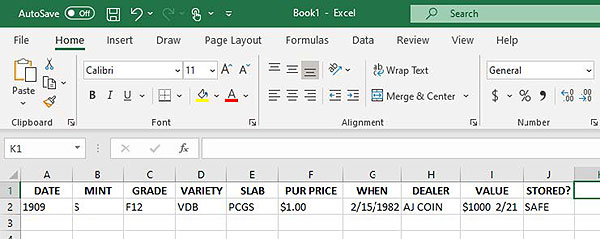
Screen shot of an Excel spreadsheet
Google Sheets in another spreadsheet program that my daughter recently introduced me to. It is remarkably like Excel in layout and design, and is free to download, then, once you have an account, you can access it from any device. As Jason pointed out, having this access on any device is great for carrying with you wherever you go. If you have an iPad or similar tablet, it is easy to pull up your spreadsheet at a coin show, check out your ‘want list’ column, see how much you think you should pay for a coin, and so on. This does eliminate the old-fashioned way of having multiple print-out sheets to page through and check off.
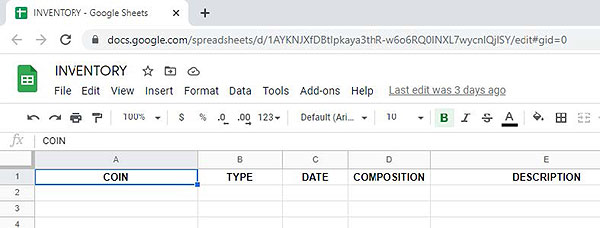
Screen shot of an Excel spreadsheet
In addition, once these programs are downloaded on your device, you do not need internet or Wi-Fi to access your spreadsheet. This is helpful because sometimes internet/WiFi is hard to come by, especially at local shows.
If you are not familiar with these types of programs, data entry, or computer stuff in general, there are good alternatives to creating your own spreadsheet. A simple Google search “Coin Collecting Software” will show you many companies that make spreadsheet-like programs specifically for coin collectors. Of course, you will have to pay anywhere from $40 to $100 for the download, plus yearly upgrades (if you so choose). Keep in mind that these are software companies, not necessarily fluent in the world of numismatics. Nevertheless, their programs are very useful for taking inventory and organizing your collection. Some examples are:
SoftPro. - Their coin program is called EZCoin, and runs $60 for the regular version, $80 for the deluxe model.
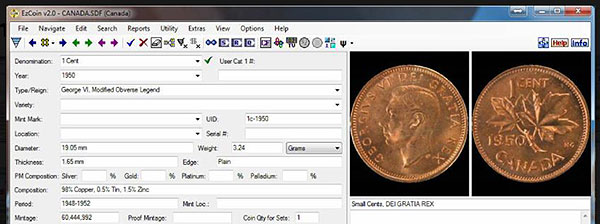
Screen shot of EZCoin
Carlisle Development – Coin Collector’s Assistant. $100
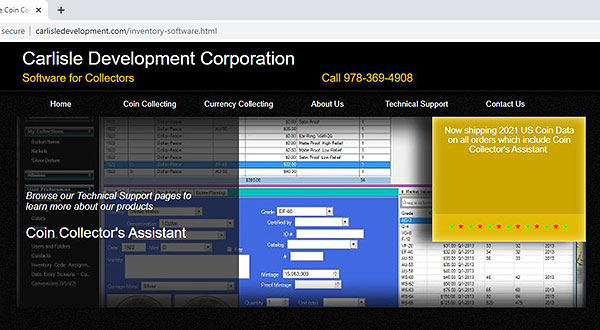
Screen shot of Coin Collector's Assistant
Liberty Street Software – CoinManage. $40 and $70 versions
(I noticed the photo on their homepage, the man pictured is clearly not a numismatist, holding both the coin and the loupe in a way that reveals CoinManage is a product of a software company, not a numismatic company.)
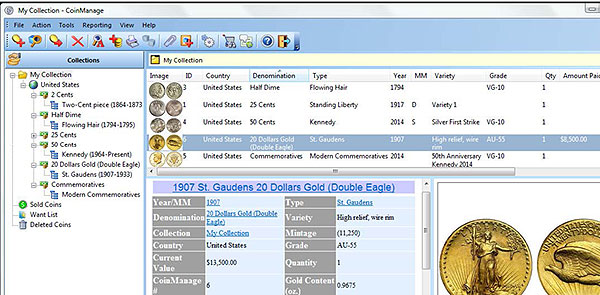
Screen shot of CoinManaget
Trove Software – Coin Elite. $80
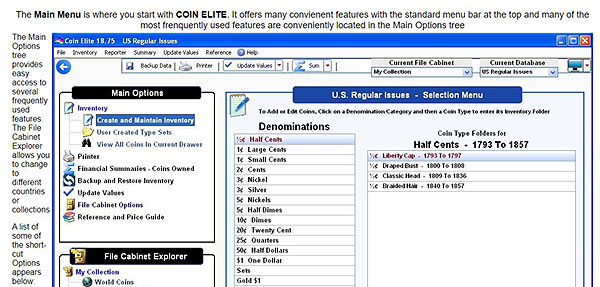
Screen shot of Coin Elite
There are more than just these examples. In addition, PCGS and NGC each have similar programs you can access through their websites. These programs will do anything you may want in your quest to organize, including the ability to upload photos and personalize your data. If you’re unsure you want to lay out the money for one of these programs, most of them offer a Free Trial so you can test them out.
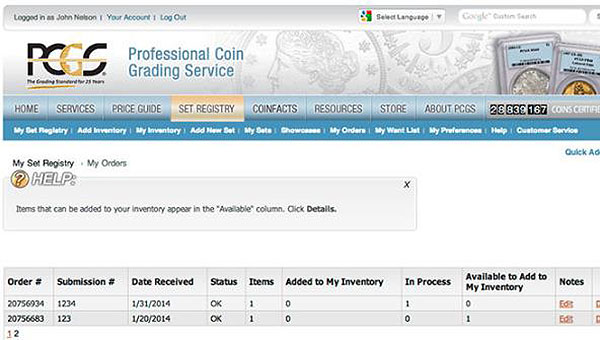
PCGS
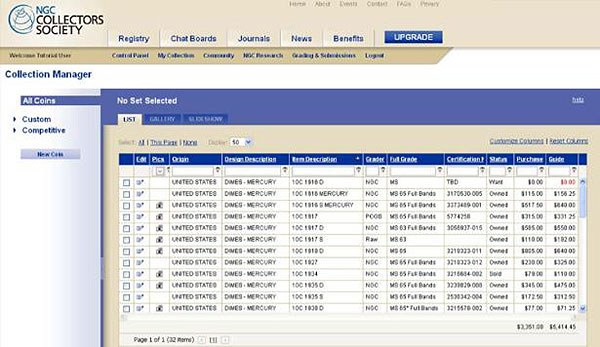
NGC
The winter months afford us the perfect time to take stock in our collections, update inventory, and perhaps think of new ways to organize it, or if you are like me, finally get started organizing it! (Special thanks to the Madison Coin Club!)
Have an interesting numismatic topic you’d like to share with your fellow NOW members?
Send your article to evan.pretzer@protonmail.com today!!!